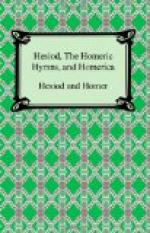(ll. 1-17) Bright-eyed Muses, tell of the Tyndaridae, the Sons of Zeus, glorious children of neat-ankled Leda, Castor the tamer of horses, and blameless Polydeuces. When Leda had lain with the dark-clouded Son of Cronos, she bare them beneath the peak of the great hill Taygetus, — children who are delivers of men on earth and of swift-going ships when stormy gales rage over the ruthless sea. Then the shipmen call upon the sons of great Zeus with vows of white lambs, going to the forepart of the prow; but the strong wind and the waves of the sea lay the ship under water, until suddenly these two are seen darting through the air on tawny wings. Forthwith they allay the blasts of the cruel winds and still the waves upon the surface of the white sea: fair signs are they and deliverance from toil. And when the shipmen see them they are glad and have rest from their pain and labour.
(ll. 18-19) Hail, Tyndaridae, riders upon swift horses! Now I will remember you and another song also.
ENDNOTES:
(1) ll. 1-9 are preserved by Diodorus Siculus iii.
66. 3; ll.
10-21 are extant only
in M.
(2) Dionysus, after his untimely birth from Semele,
was sewn
into the thigh of Zeus.
(3) sc. Semele. Zeus is here speaking.
(4) The reference is apparently to something in the
body of the
hymn, now lost.
(5) The Greeks feared to name Pluto directly and
mentioned him
by one of many descriptive
titles, such as `Host of Many’:
compare the Christian
use of O DIABOLOS or our `Evil One’.
(6) Demeter chooses the lowlier seat, supposedly
as being more
suitable to her assumed
condition, but really because in her
sorrow she refuses all
comforts.
(7) An act of communion — the drinking
of the potion here
described —
was one of the most important pieces of ritual
in the Eleusinian mysteries,
as commemorating the sorrows of
the goddess.
(8) Undercutter and Woodcutter are probably popular
names (after
the style of Hesiod’s
`Boneless One’) for the worm thought
to be the cause of teething
and toothache.
(9) The list of names is taken — with
five additions — from
Hesiod, “Theogony”
349 ff.: for their general significance
see note on that passage.
(10) Inscriptions show that there was a temple of
Apollo
Delphinius (cp. ii.
495-6) at Cnossus and a Cretan month
bearing the same name.
(11) sc. that the dolphin was really Apollo.
(12) The epithets are transferred from the god to
his altar
`Overlooking’
is especially an epithet of Zeus, as in
Apollonius Rhodius ii.
1124.
(13) Pliny notices the efficacy of the flesh of a
tortoise
against withcraft.
In “Geoponica” i. 14. 8 the living
tortoise is prescribed
as a charm to preserve vineyards from
hail.




